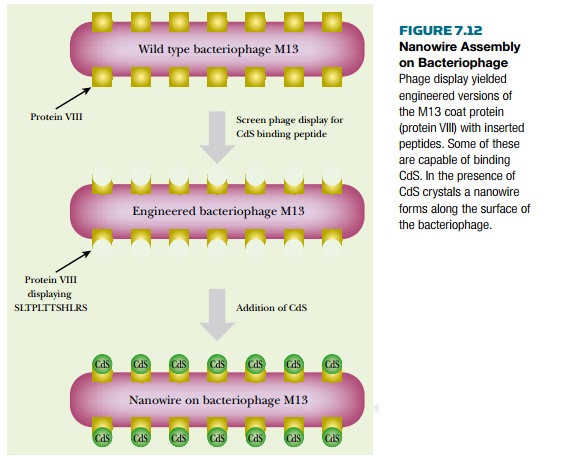Chapter: Biotechnology Applying the Genetic Revolution: Nanobiotechnology
Assembly of Nanocrystals by Microorganisms
ASSEMBLY
OF NANOCRYSTALS BY MICROORGANISMS
It has been known for many
years that bacteria may accumulate a variety of metallic elements and may
modify them chemically, usually by oxidation or reduction. For example, many
bacteria accumulate anions of selenium or tellurium and reduce them to
elemental selenium or tellurium, which is then deposited as a precipitate
either on the cell surface or internally. Certain species of the bacterium Pseudomonas that live in
metal-contaminated areas and the fungus Verticillium
can both generate silver nanocrystals.
Recently, it has been found
that when Escherichia coli is exposed
to cadmium chloride and sodium sulfide, it precipitates cadmium sulfide as
particles in the 2- to 5-nm size range. In other words, bacteria can
“biosynthesize” semiconductor nanocrystals.
Rather more sophisticated is
the use of phage display to select peptides capable of organizing semiconductor
nanowires. As described, phage display is a technique that allows the selection
of peptides that bind any chosen target molecule. In brief, stretches of DNA
encoding a library of peptide sequences are engineered into the gene for a
bacteriophage coat protein. The extra sequences are attached at either the C
terminus or N terminus, where they do not disrupt normal functioning of the
coat protein. When the hybrid protein is assembled into the phage capsid, the
inserted peptides are displayed on the outside of the phage particle.

The library of phages is then
screened against a target molecule. Those phages that bind the target are kept.
Phage display libraries have been screened to find peptides capable of binding ZnS or CdS nanocrystals. Protein VIII of bacteriophage M13 was used for peptide insertion. For example, ZnS was bound by the peptide VISNHAGSSRRL and CdS on the peptide SLTPLTTSHLRS. Because the bacteriophage capsid contains many copies of the coat protein, the displayed peptide is also present in many copies. Consequently an array of nanocrystals forms on the phage surface. Because M13 is a filamentous phage, the result is a semiconductor nanowire (Fig. 7.12).
Related Topics